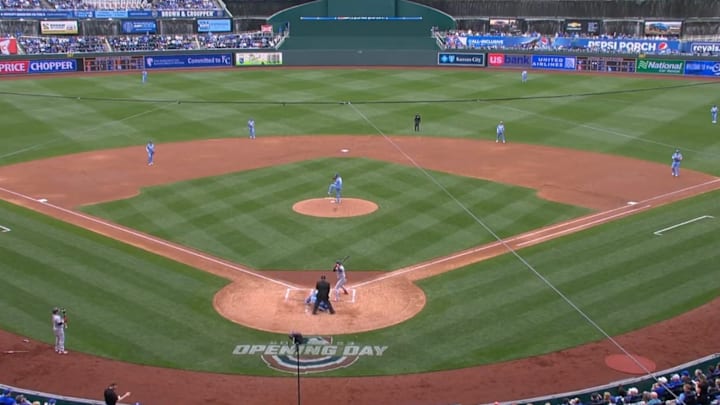It didn’t take long for a team to try and work it’s way around the new MLB’s new shift ban.
For the first time, defenses are not allowed to strategically shift to try and defend against a batter’s tendencies. It’s a new rule that the league is hoping restores some offensive firepower to games, and help players like Max Kepler return to previous form.
Kelper might have wanted to look away on Thursday in Kansas City when Joey Gallo came to bat. The Royals didn’t shift its defense in the way teams used to, but still moved its outfield into a wonky formation.
Royals right fielder MJ Melendez moved up to play in shallow right, which is where a second baseman would have moved back in the days of legal shifting. Despite how it may seem, this, isn’t a violation of the new ban but is instead a risky exploitation of it.
And it worked, at least in theory.
Melendez was in position to turn what should have been a single into an out, but ended up committing an error. That won’t be the takeaway from this, as teams will look past the human error and see that the strategy to get around the shift works.
Royals brought right fielder MJ Melendez way in vs. Joey Gallo, basically playing him at deep second base, and shaded the other outfielders toward right field to cover for him.
— Aaron Gleeman (@AaronGleeman) March 30, 2023
So what happened? Gallo hit a grounder directly to Melendez ... and he bobbled the ball for an error. pic.twitter.com/8IglIymHbu
This isn’t the first time a team has tried to find a loophole in the new shift ban, nor was it the first time a team tried it on Gallo.
Back in Spring Training the Boston Red Sox attempted a “Two Man Outfield” by moving its left fielder over to right. This left one side of the outfield wide open, but was a designed to defend against Gallo’s tendency to pull the ball to the right side of the field.
Joey Gallo will never escape the shift pic.twitter.com/At9kbDbOSl
— 4 Train Savages (@FourSavages) March 4, 2023
Teams are still going to shift fielders to try and better defend against hitters and can do so without breaking the new rule.
What is the new Shift Ban and why can teams still move fielders?
So how can the Royals do this without breaking the rules? The new shift ban is mostly about the infield, as there can be no more than two players on either side of the diamond and they have to stay on the infield dirt until the ball is in play.
This means that Carlos Correa can’t move to the right side of second base and can’t back up into the outfield grass of shallow left or center. Similarly whoever is at second base can’t move into right field to get behind the ball before it’s hit — which is what the Royals exploited on the Gallo play.
In years past, Melendez wouldn’t have needed to move up because Michael Massey would have moved into shallow right and made the play to get Gallo out. Because of the shift ban, Massey had to stay on the infield dirt and Melendez needed to move up. Kansas City accounted for this by going with a ‘Two Man Outfield’ and shifted Kyle Isbel and Edward Olivares over.
It’s a lot, but it’s the sort of convoluted workaround that baseball savants have been perfecting for as long as the game has existed.
This is bad news for Max Kepler and players like him who were hoping the shift ban would help open up the defense a little. It’s not the end of the world, as it does leave the defense exposed, but it’s only a matter of time before a team figures out how to perfect the method.
Of course, there’s a flip side to that coin. For as annoying as it will be for hitters to deal with defenses exploiting the loophole, there’s a tremendous amount of risk involved. Had Gallo pulled the ball to left, it would have turned what might have otherwise been a single or a routine out into an extra bases hit.
That’s ultimately the gamble teams will take when trying to shift without actually shifting, and it’s going to be a mess before it’s strategically figured out.
However, it will only take a few of instances of routine outs turning into base hits or runs for teams to re-think trying to jerry-rig a shift without actually violating the new ban.
